Abstract
Foragers of the ant Formica schaufussi recruit nestmates to large anthropod prey and cooperatively transport the prey to the nest. The size of the group of ants retrieving prey is significantly correlated with the prey mass at the point at which the retrieval group reaches the nest entrance. To understand the mechanism involved in this “size matching” process, the regulation of retrieval group size was investigated by examining the modulatory role of trail pheromones in recruitment communication and the behavioral processes that might adjust retrieval group size to prey mass. Laboratory studies of hindgut, poison, and Dufour's gland extracts showed that the contents of the hindgut, which was determined to be the source of trail pheromone, induced recruitment and orientation behavior in ants and regulated the recruitment response of ants in the absence of any other communication signal. However, chemical mass communication alone did not appear to explain the regulation of retrieval group size. Scout ants assess whether to collect prey individually or recruit nestmates to group-retrieve 100-, 200-, or 400-mg prey but did not vary group size in relation to either the prey mass or the presence of interspecific competitors once the decision to initiate group retrieval was made. The number of recruits leaving the nest was independent of these factors and first matched prey mass during prey transport, possibly through a process of differential individual response to immobile versus mobile prey items. Unpredictable factors such as prey resistance to movement and rapidly changing degrees of interspecific competition may preclude scouts from fine-tuning the retrieval group size before it reaches the prey.
Similar content being viewed by others
REFERENCES
Adams, E. A., and Traniello, J. F. A. (1981). Chemical interference competition by Monomorium minimum. Oecologia 51: 265–270.
Aron, S., Pasteels, J. M., Goss, S., and Deneubourg, J. L. (1990). Self-organizing spatial patterns in the Argentine ant Iridomyrmex humilis (Mayr). In Applied Myrmecology: A World Perspective, Vander Meer, R. K., Jaffe, K., and Cedeno, R. (eds.), Westview Press, Boulder, CO, pp. 438–451.
Breed, M. D., Fewell, J. H., Moore, A. J., and Wiliams, K. R. (1987). Graded recruitment in a ponerine ants. Behav. Ecol. Sociobiol. 20: 407–411.
Cammaerts, M. C., and Cammaerts, R. (1980). Food recruitment strategies of the ants Myrmica sabuletti and Myrmica ruginodis. Behav. Process. 5: 251–270.
Chauvin, R. (1968). Sur le transport collectif des proies par Formica polyctena. Insectes Soc. 25: 193–200.
Chauvin, R. (1971). Les lois de l'ergonomie chez les Fourmis au cours du transport d'objets. C.R. Acad. Sci. Paris D 273: 1862–1865.
Crawford, D. L., and Rissing, S. W. (1983). Regulation of recruitment by individual scouts in Formica oreas Wheeler (Hymenoptera, Formicidae). Insectes Soc. 30: 177–183.
Deneubourg, J. L., and Goss, S. (1989). Collective patterns and decision-making. Ethol. Ecol. Evol. 1: 295–311.
Deneubourg, J. L., Goss, S., Franks, N., and Pasteels, J. M. (1989). The blind leading the blind: Modelling chemically mediated army ant raid patterns. J. Insect. Behav. 2: 719–725.
Detrain, C., and Deneubourg, J. L. (1997). Scavenging by Pheidole pallidula: A key for understanding decision-making systems in ants. Anim. Behav. 53: 537–547.
Dlussky, G. M., Voltzit, O. V., and Sulkhanov, A. V. (1978). Organization of group foraging in ants of the genus Myrmica. Zool. Zh. 57: 65–77.
Fourcassié, V., and Traniello, J. F. A. (1993). Effects of experience on food-searching behavior in the ant Formica schaufussi (Hymenoptera, Formicidae). J. Insect Behav. 6: 287–299.
Franks, N. R. (1986). Teams in social insects: Group retrieval of prey by army ants (Eciton burchelli, Hymenoptera: Formicidae). Behav. Ecol. Sociobiol. 18: 425–429.
Franks, N. R. (1989). Army ants: A collective intelligence. Am. Sci. 77: 139–145.
Franks, N. R., and Fletcher, C. R. (1983). Spatial patterns in army ant foraging and migration: Eciton burchelli on Barro Colorado, Panama. Behav. Ecol. Sociobiol. 12: 261–270.
Franks, N. R., Gomez, N., Goss, S., and Deneubourg, J. L. (1991). The blind leading the blind in army ant raid patterns: Testing a model of self-organization (Hymenoptera: Formicidae). J. Insect Behav. 4: 583–607.
Goss, S., and Deneubourg, J. L. (1989). The self-organizing clock pattern of Messor pergandei (Formicidae, Myrmicinae). Insectes Soc. 36: 339–346.
Hangartner, W. (1969). Structure and variability of the individual odor trail in Solenopsis geminata Fabr. (Hymenoptera, Formicidae). Z. Vergl. Physiol. 62: 111–120.
Hölldobler, B. (1971). Recruitment behavior in Camponotus socius (Hym. Formicidae). Z. Vergl. Physiol. 75: 123–142.
Hölldobler, B. (1976). Recruitment behavior, home range orientation and territoriality in harvester ants, Pogonomyrmex. Behav. Ecol. Sociobiol. 1: 3–44.
Hölldobler, B. (1983). Territorial behavior in the green tree ant (Oecophylla smaragdina). Biotropica 14: 241–250.
Hölldobler, B., and Wilson, E. O. (1990). The Ants, Belknap Press, Cambridge, MA.
Hölldobler, B., Stanton, R. C., and Markl, H. (1978). Recruitment and food retrieving behavior in Novomessor (Formicidae, Hymenoptera). I. Chemical signals. Behav. Ecol. Sociobiol. 4: 163–181.
Markl, H., and Hölldobler, B. (1978). Recruitment and food-retrieving behavior in Novomessor (Formicidae, Hymenoptera). II. Vibration signals. Behav. Ecol. Sociobiol. 4: 183–216.
Meyer, J.-A. (1970). Sur les lois régissant l'accomplissement d'une tâche collective complexe chez Formica polyctena. C. R. Acad. Sci. Paris D 270: 2111–2114.
Moffett, M. W. (1987). Division of labor and diet in the extremely polymorphic ant Pheidologeton diversus. Natl. Geogr. Res. 3: 282–304.
Moffett, M. W. (1988a). Cooperative food transport by an Asiatic ant. Natl. Geogr. Res. 4: 386–394.
Moffett, M. W. (1988b). Foraging dyanmics in the group-hunting Myrmicine ant, Pheidologeton diversus. J. Insect Behav. 1: 309–311.
Möglich, M., and Hölldobler, B. (1975). Communication and orientation during foraging and emigration in the ant Formica fusca. J. Comp. Physiol. A 101: 275–288.
Nonacs, P., and Dill, L. M. (1990). Mortality risk vs. food quality trade-offs in a common currency: Ant patch preferences. Ecology 71: 1886–1892.
Nonacs, P., and Dill, L. M. (1991). Mortality risk vs. food quality trade-offs in ants: Patch use over time. Ecol. Entomol. 16: 73–80.
Pasteels, J. M., Deneubourg, J. L., and Goss, S. (1987). Self-organization mechanisms in ant societies (1): Trail recruitment to newly discovered food sources. In Pasteels, J. M., and Deneubourg, J. L. (eds.), From Individual to Collective Behavior in the Social Insects, Birkhauser, Basel, pp. 155–174.
Roces, F., Tautz, J., and Hölldobler, B. (1993). Stridulation in leaf cutting ants: Short-range recruitment communication through plant-borne vibrations. Naturwissenschaften 80: 521–524.
Schneirla, T. C. (1971). Army Ants: A Study in Social Organization, Freeman, San Francisco.
Seeley, T. D. (1989a). Social foraging in honey bees: How nectar foragers assess their colony's nutritional status. Behav. Ecol. Sociobiol. 24: 181–199.
Seeley, T. D. (1989b). The honey bee colony as a superorganism. Am. Sci. 77: 546–552.
Seeley, T. D., Camazine, S., and Sneyd, J. (1991). Collective decision-making in honey bees: How colonies chose among nectar sources. Behav. Ecol. Sociobiol. 28: 277–290.
Sorenson, A. A., Busch, T. M., and Vinson, S. B. (1983). Behavior of workers subcastes in the fire ant, Solenopsis invicta, in response to proteinaceous food. Physiol. Entomol. 8: 83–92.
Sorenson, A. A., Busch, T. M., and Vinson, S. B. (1985). Control of food influx by temporal subcastes in the fire ant, Solenopsis invicta. Behav. Ecol. Sociobiol. 17: 191–198.
Sudd, J. H. (1960). The transport of prey by an ant, Pheidole crassinoda Em. Behavior 16: 295–308.
Sudd, J. H. (1963). How insects work in groups. Discovery 24(June): 15–19.
Taylor, F. (1977). Foraging behavior in ants: Experiments with two species of myrmecine ants. Behav. Ecol. Sociobiol. 2: 147–168.
Traniello, J. F. A. (1977). Recruitment behavior, orientation and the organization of foraging in the carpenter ant Camponotus pennsylvanicus De Geer (Hymenoptera: Formicidae). Behav. Ecol. Sociobiol. 2: 61–79.
Traniello, J. F. A. (1987a). Individual and social modification of behavior in response to environmental factors in ants. In Pasteels, J. M., and Deneubourg, J. L. (eds.), From Individual to Collective Behavior in Social Insects, Birkhauser, Basel, pp. 63–80.
Traniello, J. F. A. (1987b). Comparative foraging ecology of north temperate ants: The role of worker size and cooperative foraging in prey selection. Insectes Soc. 34: 118–130.
Traniello, J. F. A. (1988). Variation in foraging behavior among workers of the ant Formica schaufussi; Ecological correlates of search behavior and the modification of search pattern. In Jeanne, R. L. (ed.), Interindividual Behavioral Variation in Social Insects, Westview Press, Boulder, CO, pp. 91–112.
Traniello, J. F. A. (1989). Foraging strategies of ants. Annu. Rev. Entomol. 34: 191–210.
Traniello, J. F. A., and Beshers, S. N. (1991). Maximization of foraging efficiency and resource defense by group retrieval in the ant Formica schaufussi. Behav. Ecol. Sociobiol. 29: 283–289.
Traniello, J. F. A., and Robson, S. K. (1995). Trail and territorial communication in social insects. In Bell, W., and Cardé, R. (eds.), The Chemical Ecology of Insects, Vol. 2, Chapman and Hall, New York, pp. 241–286.
Traniello, J. F. A., Kozol, A. J., and Fournier, M. A. (1992). Resource-related spatial patterns of search in the ant Formica schaufussi: A field study. Psyche 99: 87–93.
Visscher, P. K., and Seeley, T. D. (1982). Foraging strategy of honeybee colonies in a temperate deciduous forest. Ecology 63: 1790–1801.
Wilson, E. O. (1962). Chemical communication among workers of the fire ant Solenopsis saevissima (Fr. Smith). 1. The organization of mass foraging. Anim. Behav. 10: 134–147.
Wilson, E. O. (1976). The organization of colony defense in the ant Pheidole dentata Mayr (Hymenoptera: Formicidae). Behav. Ecol. Sociobiol. 1: 63–81.
Author information
Authors and Affiliations
Rights and permissions
About this article
Cite this article
Robson, S.K., Traniello, J.F.A. Resource Assessment, Recruitment Behavior, and Organization of Cooperative Prey Retrieval in the Ant Formica schaufussi (Hymenoptera: Formicidae). Journal of Insect Behavior 11, 1–22 (1998). https://doi.org/10.1023/A:1020859531179
Issue Date:
DOI: https://doi.org/10.1023/A:1020859531179




